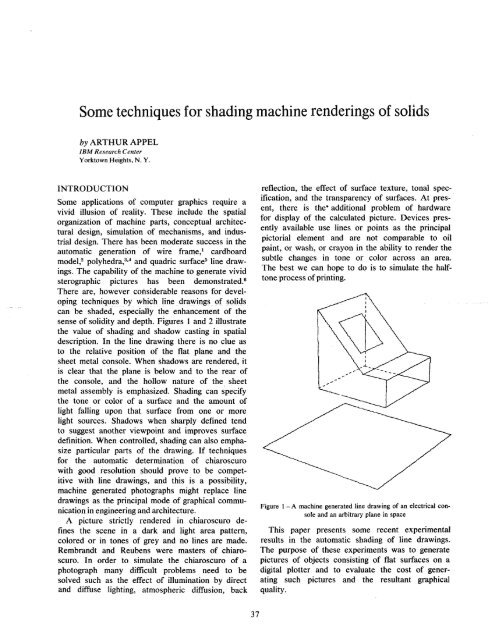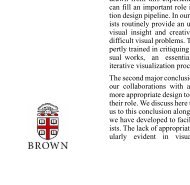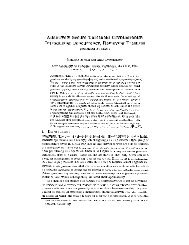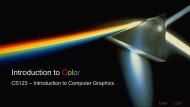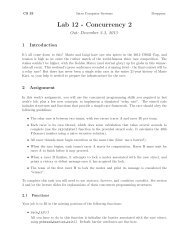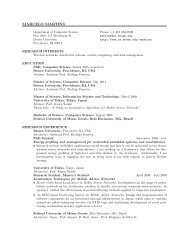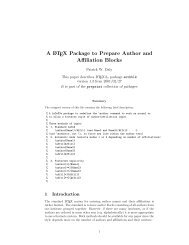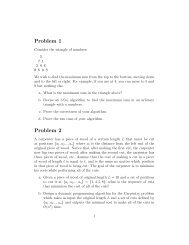Some techniques for shading machine renderings of solids
Some techniques for shading machine renderings of solids
Some techniques for shading machine renderings of solids
You also want an ePaper? Increase the reach of your titles
YUMPU automatically turns print PDFs into web optimized ePapers that Google loves.
<strong>Some</strong> <strong>techniques</strong> <strong>for</strong> <strong>shading</strong> <strong>machine</strong> <strong>renderings</strong> <strong>of</strong> <strong>solids</strong><br />
by ARTHUR APPEL<br />
IBM Research Center<br />
Yorktown Heights, N. Y.<br />
INTRODUCTION<br />
<strong>Some</strong> applications <strong>of</strong> computer graphics require a<br />
vivid illusion <strong>of</strong> reality. These include the spatial<br />
organization <strong>of</strong> <strong>machine</strong> parts, conceptual architectural<br />
design, simulation <strong>of</strong> mechanisms, and industrial<br />
design. There has been moderate success in the<br />
automatic generation <strong>of</strong> wire frame, 1 cardboard<br />
model, 2 polyhedra, 3,4 and quadric surface 5 line drawings.<br />
The capability <strong>of</strong> the <strong>machine</strong> to generate vivid<br />
sterographic pictures has been demonstrated. 6<br />
There are, however considerable reasons <strong>for</strong> developing<br />
<strong>techniques</strong> by which line drawings <strong>of</strong> <strong>solids</strong><br />
can be shaded, especially the enhancement <strong>of</strong> the<br />
sense <strong>of</strong> solidity and depth. Figures 1 and 2 illustrate<br />
the value <strong>of</strong> <strong>shading</strong> and shadow casting in spatial<br />
description. In the line drawing there is no clue as<br />
to the relative position <strong>of</strong> the flat plane and the<br />
sheet metal console. When shadows are rendered, it<br />
is clear that the plane is below and to the rear <strong>of</strong><br />
the console, and the hollow nature <strong>of</strong> the sheet<br />
metal assembly is emphasized. Shading can specify<br />
the tone or color <strong>of</strong> a surface and the amount <strong>of</strong><br />
light falling upon that surface from one or more<br />
light sources. Shadows when sharply defined tend<br />
to suggest another viewpoint and improves surface<br />
definition. When controlled, <strong>shading</strong> can also emphasize<br />
particular parts <strong>of</strong> the drawing. If <strong>techniques</strong><br />
<strong>for</strong> the automatic determination <strong>of</strong> chiaroscuro<br />
with good resolution should prove to be competitive<br />
with line drawings, and this is a possibility,<br />
<strong>machine</strong> generated photographs might replace line<br />
drawings as the principal mode <strong>of</strong> graphical communication<br />
in engineering and architecture.<br />
A picture strictly rendered in chiaroscuro defines<br />
the scene in a dark and light area pattern,<br />
colored or in tones <strong>of</strong> grey and no lines are made.<br />
Rembrandt and Reubens were masters <strong>of</strong> chiaroscuro.<br />
In order to simulate the chiaroscuro <strong>of</strong> a<br />
photograph many difficult problems need to be<br />
solved such as the effect <strong>of</strong> illumination by direct<br />
and diffuse lighting, atmospheric diffusion, back<br />
37<br />
reflection, the effect <strong>of</strong> surface texture, tonal specification,<br />
and the transparency <strong>of</strong> surfaces. At present,<br />
there is the* additional problem <strong>of</strong> hardware<br />
<strong>for</strong> display <strong>of</strong> the calculated picture. Devices presently<br />
available use lines or points as the principal<br />
pictorial element and are not comparable to oil<br />
paint, or wash, or crayon in the ability to render the<br />
subtle changes in tone or color across an area.<br />
The best we can hope to do is to simulate the halftone<br />
process <strong>of</strong> printing.<br />
Figure 1—A <strong>machine</strong> generated line drawing <strong>of</strong> an electrical console<br />
and an arbitrary plane in space<br />
This paper presents some recent experimental<br />
results in the automatic <strong>shading</strong> <strong>of</strong> line drawings.<br />
The purpose <strong>of</strong> these experiments was to generate<br />
pictures <strong>of</strong> objects consisting <strong>of</strong> flat surfaces on a<br />
digital plotter and to evaluate the cost <strong>of</strong> generating<br />
such pictures and the resultant graphical<br />
quality.
Spring Joint Computer Conference, 1968<br />
Figure 2 —A shaded line drawing <strong>of</strong> the scene in Figure 1<br />
Previous work<br />
Considerable work has been done in the digitizing<br />
<strong>of</strong> photographs. 7,8 Especially successful are the<br />
pictures transmitted from spacecraft. 9 The significance<br />
<strong>of</strong> this work is the demonstration <strong>of</strong> the quality <strong>of</strong><br />
digitally generated pictures.<br />
L. G. Roberts has accomplished the converse <strong>of</strong> the<br />
problem being discussed in this paper by developing<br />
<strong>techniques</strong> <strong>for</strong> the <strong>machine</strong> perception <strong>of</strong> <strong>solids</strong> which<br />
are assemblies <strong>of</strong> convex poiyhedra modules. 10<br />
His work suggests the possibility that it may be<br />
more useful to analyze the contents <strong>of</strong> a photograph<br />
and to create a mathematical model <strong>of</strong> the scene.<br />
This analysis can be used to generate any view <strong>of</strong><br />
the scene with greater graphical control.<br />
G. Lasher has written a program which can be<br />
used to generate three dimensional graphs <strong>of</strong> mathematical<br />
functions which are unique <strong>for</strong> values <strong>of</strong><br />
X and Y. This program, which was used to illustrate<br />
an article in theoretical physics, 11 generates contour<br />
curves <strong>of</strong> the surface, constant coordinate<br />
curves and renders only those curve segments that<br />
are visible in a perspective projection. A <strong>shading</strong><br />
effect occurs in these pictures because the projection<br />
<strong>of</strong> the surface rulings tend to concentrate as the<br />
surface becomes tangent to the line <strong>of</strong> sight. This<br />
effect contributes significantly to the vividness <strong>of</strong><br />
the <strong>renderings</strong>.<br />
J. L. Pfaltz and A. Rosenfeld have applied their<br />
notions on encoding plane regions to <strong>shading</strong> two<br />
dimensional maps. 12 Their notion <strong>of</strong> skeleton representation<br />
is that a region can be specified by a list<br />
<strong>of</strong> points on a plane and a radius; all parts <strong>of</strong> the plane<br />
within the radius <strong>of</strong> the point are within the region<br />
described. For <strong>shading</strong>, a set <strong>of</strong> parallel straight lines<br />
are generated and those portions <strong>of</strong> the lines which be<br />
within the region are rendered. The angle and spacing<br />
<strong>of</strong> the set <strong>of</strong> parallel lines can be varied and other<br />
textures can be generated.<br />
A vivid automatically shaded picture <strong>of</strong> a polyhedron<br />
was generated by a subroutine written by<br />
B. Archer <strong>for</strong> an article by A. T. Coie. 13 The <strong>shading</strong><br />
is accomplished by varying the spacing <strong>of</strong> parallel<br />
lines. The spacing <strong>of</strong> lines on a particular surface<br />
is proportional to the illumination. No attempt was<br />
made to determine the shadow cast by the polyhedron<br />
and the methods described are inadequate <strong>for</strong> drawing<br />
more than one convex poiyhedra at a time.<br />
Recently, C. Wylie, G. Romney, D. Evans, and A.<br />
Erdahl 13 published an algorithm <strong>for</strong> generation <strong>of</strong><br />
half-tone pictures <strong>of</strong> objects described by assemblies<br />
<strong>of</strong> triangular bounded planes. Their results are toned<br />
pictures generated with calculation time competitive<br />
with line drawings. However their scheme sets<br />
the source <strong>of</strong> illumination at the viewpoint, and since<br />
a point light source cannot see the shadows it casts,<br />
no shadows are rendered.<br />
Previous work in the automatic determination <strong>of</strong><br />
chiaroscuro demonstrates how the computer can<br />
improve the level <strong>of</strong> graphics designers can work with.<br />
The primary limitation has been neglect <strong>of</strong> shadow<br />
casting from arbitrarily located light sources. Also<br />
no work has been done on the control <strong>of</strong> the toned<br />
picture to take into account the surface tone or color<br />
<strong>of</strong> an object. Any system <strong>for</strong> rendering in chiaroscuro<br />
should solve economically at least these two problems.<br />
It can be seen from previous results that toning an<br />
area by varying the spacing <strong>of</strong> parallel lines is not<br />
entirely satisfactory. This technique is economic but<br />
has several disadvantages. The lines when widely<br />
spaced do not fuse to <strong>for</strong>m a continuous tone. The<br />
viewer does not then perceive the object but is distracted<br />
by the two dimensional pattern. Depth perception<br />
is reduced. These lines aiso tend to suggest<br />
a surface finish which may not exist. A good standard<br />
<strong>for</strong> evaluating toning mechanics can be the ben-day<br />
pattern used in printing. This pattern enables a great<br />
range <strong>of</strong> dark and light with good tonal fusion. The<br />
half-tone process uses many small dots arranged in a<br />
regular array. The size <strong>of</strong> dots are varied to create a<br />
degree <strong>of</strong> grayness, small dots where white predominates<br />
are light and as the dots increase in size such that
they eventually blend together the toned region becomes<br />
darker. In order <strong>for</strong> the dot pattern not to be<br />
distracting, the dot spacing should be at least seventy<br />
dots to the inch. The large dot density required <strong>for</strong><br />
toning indicates that calculation schemes <strong>for</strong> toning<br />
should be as resolution independent as possible. For<br />
an algorithm to be resolution independent it must<br />
enable perfect resolution. It may not be possible <strong>for</strong><br />
contemporary hardware to take advantage <strong>of</strong> such an<br />
algorithm but this should be the goal.<br />
Toning on a digital plotter<br />
A great many experiments were conducted to<br />
evaluate the quality <strong>of</strong> various toning <strong>techniques</strong> that<br />
would be applicable to digital plotting. A simulation<br />
technique tested was to shoot random light rays from<br />
the light source at the scene and project a symbol<br />
from the piercing point on the first surface the light<br />
ray pierced. These symbols would concentrate in<br />
regions <strong>of</strong> high light intensity, and a negative print <strong>of</strong><br />
the hard copy could be made which would approximate<br />
a photograph if enough light rays are generated.<br />
Even <strong>for</strong> about 1000 light rays results were splotchy.<br />
Generating light rays in regular patterns improved the<br />
graphic quality but did not allow economic tonal control.<br />
During these experiments, various symbols were<br />
evaluated <strong>for</strong> graphic quality and speed <strong>of</strong> plotter<br />
generation. The plus sign or a small square were to<br />
give best results. Eventually the best technique from<br />
graphic and economic considerations <strong>for</strong> toning was<br />
found to be plus signs arranged in staggered rows<br />
with shadows outlined. This arrangement is most<br />
easily seen in Figure 2. The size <strong>of</strong> plus signs were to<br />
be rendered proportional to darkness required.<br />
Ignoring atmospheric diffusion, the intensity <strong>of</strong><br />
light incident upon a unit plane area from a point<br />
light source is:<br />
I = S (Cosine L)/D 2<br />
where S is the intensity <strong>of</strong> the light source, L is the<br />
angle <strong>of</strong> the normal to the plane and direction <strong>of</strong> light<br />
at the illuminated area, and D is the distance from the<br />
illuminated point to the light source. For experimental<br />
purposes it was assumed that the light source is so far<br />
from the objects being illuminated that variations in<br />
L and D are insignificant. L need be calculated only<br />
once <strong>for</strong> each surface. Also since we are interested<br />
in simulating illumination only to the extent that comparative<br />
light and darkness <strong>of</strong> surfaces are displayed<br />
and also because the range <strong>of</strong> toning on the digital<br />
plotter is limited, we did not concern ourselves with<br />
the actual intensity <strong>of</strong> the single light source. The<br />
comparative intensity <strong>of</strong> illumination <strong>of</strong> a point on<br />
a plane then is proportional to Cosine L. The apparent<br />
illumination <strong>of</strong> a flat surface then will be constant<br />
Techniques <strong>for</strong> Shading Machine Renderings <strong>of</strong> Solids 3 9<br />
over the surface. The digital plotter does not generate<br />
light as a cathode ray tube but makes a dark mark. The<br />
size <strong>of</strong> this mark should indicate an absence <strong>of</strong> light.<br />
So the degree <strong>of</strong> darkness at a point or the size <strong>of</strong><br />
plus sign rendered is<br />
H*=l-Cosine L<br />
For simplicity it can be assumed that if a point is<br />
in shadow the largest allowable mark will be rendered<br />
on that point. For point j then, the size <strong>of</strong> symbol H,<br />
is the maximum symbol Hs. Hs is proportional to the<br />
dot spacing. During early experiments <strong>of</strong> the size <strong>of</strong><br />
symbols rendered on a point not in shadow was<br />
Hj = 1 — Cosine L<br />
However it was found that results were confusing; it<br />
was difficult to detect the difference between surfaces<br />
in shadow and surfaces almost parallel to the direction<br />
<strong>of</strong> light. In actual viewing <strong>of</strong> a solid, surfaces almost<br />
parallel to the direction <strong>of</strong> light reflect a considerable<br />
amount <strong>of</strong> light due to the surface roughness, but as<br />
soon as the surface faces away from the light source,<br />
no light can be reflected and the apparent illumination<br />
changes sharply. In order to simulate this effect a<br />
contrast factor, h, usually .8, was introduced. So then<br />
Hj = hHs(l -Cosine L) (la)<br />
if the surface point j is on faces the light source and<br />
Hj = Hs if point j is in shadow. (lb)<br />
We are faced now with essentially at least four programming<br />
problems:<br />
1. Given a viewpoint and a mathematically described<br />
scene what is the point in picture to point<br />
in scene correspondence? This problem is to determine<br />
what visible point, if any, on the objects<br />
being rendered project onto a particular point in<br />
the picture plane.<br />
2. Given one or more light sources what is the intensity<br />
<strong>of</strong> light falling on a point in the scene?<br />
This problem includes the determination <strong>of</strong><br />
which regions are in shadow.<br />
3. Given a light source what are the boundaries <strong>of</strong><br />
the shadow cast and how much <strong>of</strong> this cast<br />
shadow can be seen? If the picture could be<br />
rendered large and/or if symbol density could be<br />
large outlining the shadows could be dispensed<br />
with.<br />
4. How can the tone or color <strong>of</strong> a surface be specified<br />
and how should this specification affect the<br />
tones rendered?<br />
Economic solutions to the first two problems are<br />
most critical. If an economic point to point correspondence<br />
technique could be found that would permit<br />
dense symbol packing, the problem <strong>of</strong> casting<br />
shadow outlines could be eliminated. The problem <strong>of</strong>
40 Spring Joint Computer Conference, 1968<br />
determining how much light falls on a flat surface not<br />
in shadow is trivial, and even <strong>for</strong> curved surfaces this<br />
is not difficult, but economically determining exactly<br />
what regions <strong>of</strong> the scene are in shadow is a very difficult<br />
problem.<br />
Figure 3 — An assembly <strong>of</strong> planes which make up a cardboard model<br />
<strong>of</strong> a building<br />
Figure 4—Another view <strong>of</strong> the building<br />
Figure 5 — A higher angle view <strong>of</strong> the building. 7094 calculation time<br />
<strong>for</strong> this picture was about 30 minutes.<br />
SHADOW<br />
BOUN0ARY<br />
Point by point <strong>shading</strong><br />
-LIGHT SOURCE<br />
Figure 6 —Point by point <strong>shading</strong><br />
OBSERVER<br />
LINE OF SIGHT<br />
PNp DOES NOT<br />
CORRESPOND TO<br />
ANY POINT ON<br />
THE OBJECT<br />
Point by point <strong>shading</strong> <strong>techniques</strong> yield good<br />
graphic results but at large computational times. These<br />
<strong>techniques</strong> are docile, require the minimum <strong>of</strong> storage<br />
and enable easily coded graphical experimentation.<br />
Figures 3, 4, and 5 are examples <strong>of</strong> point by point<br />
<strong>shading</strong>. Referring to Figure 6, the technique in generating<br />
these pictures was as follows:<br />
1. Determine the range <strong>of</strong> coordinates <strong>of</strong> the projection<br />
<strong>of</strong> the vertex points.<br />
2. Within this range generate a roster <strong>of</strong> spots<br />
(Pip) in the picture plane, reproject these spots<br />
one at a time to the eye <strong>of</strong> the observer and generate<br />
the equation <strong>of</strong> the line <strong>of</strong> sight to that spot.<br />
3. Determine the first plane the line <strong>of</strong> sight to a<br />
particular spot pierces. Locate the piercing point<br />
(Pi) in space. Ignore the spots that do not corre-<br />
apoiiu IU pv/iiiua m iiii^ SvCuv ^i np/ -<br />
4. Determine whether the piercing point is hidden<br />
from the light source by any other surface. If the<br />
point is hidden from the light source (<strong>for</strong> example<br />
P2) or if the surface the piercing point is on<br />
is being observed from its shadow side, mark on<br />
the roster spot the largest allowable plus sign Hs.<br />
If the point in space is visible to the light source<br />
(<strong>for</strong> example Px) draw a plus sign with dimension<br />
Hj as determined by Equation 1.<br />
This method is very time consuming, usually requiring<br />
<strong>for</strong> useful results several thousand times as<br />
much calculation time as a wire frame drawing. About<br />
one half <strong>of</strong> this time is devoted to determining the<br />
point to point correspondence <strong>of</strong> the projection and<br />
the scene. In order to minimize calculation time <strong>for</strong><br />
point by point <strong>shading</strong> and maintain resolution, <strong>techniques</strong><br />
were developed to determine the outline <strong>of</strong> cast<br />
shadows. Outlining shadows has the advantage that<br />
all regions <strong>of</strong> dissimilar tones on the picture plane<br />
are outlined. Even when projected shadows are delicate,<br />
and symbol spacing is large, the shadows are<br />
specified and the discontinuity in tone is emphasized.<br />
The strategy <strong>for</strong> point by point determination <strong>of</strong><br />
shadow boundaries is as follows: (Referring to Figure<br />
7)<br />
TYPICAL<br />
SHADOW<br />
CASTING<br />
LINE<br />
NON-SHADOW<br />
CASTING LINE<br />
rLIGHT SOURCE<br />
-SURFACE UPON WHICH<br />
SHADOW WILL FALL<br />
Figure 7 —Segment by segment outlining <strong>of</strong> shadows
1. Classify all surface line boundaries into shadow<br />
casting and non-shadow casting. A shadow casting<br />
line is from the viewpoint <strong>of</strong> an observer<br />
at the light source a contour line. For assemblies<br />
<strong>of</strong> flat surfaces, a contour line along which all<br />
surfaces associated with this line appear on only<br />
one side <strong>of</strong> this line.<br />
2. Determine whether the observer is on the shadow<br />
side or lighted side <strong>of</strong> all surfaces.<br />
3. Subdivide all shadow casting lines, one at a<br />
time, into small segments (Kl, K2), usually .005<br />
units, and determine the midpoint <strong>of</strong> this segment<br />
(KM).<br />
4. Generate a light ray to the midpoint <strong>of</strong> the segment<br />
(KM). If any surface lies between KM and<br />
the light source go on to the next segment. Determine<br />
the next surface behind KM that the light<br />
ray to KM pierces within its boundary. If no surface<br />
lies behind KM go on to the next segment.<br />
A point can cast only one shadow. Project Kl,<br />
KM, and K2 onto the surface to obtain K1S,<br />
KMS, and K2S, the shadows <strong>of</strong> Kl, KM, and<br />
K2. If KMS lies on a surface which is seen from<br />
its shadow side go on to the next segment. This<br />
particular shadow boundary is invisible. Also<br />
a shadow cannot fall within a shadow.<br />
5. Test KMS <strong>for</strong> visibility. If KMS is hidden from<br />
the observer go on to the next segment.<br />
6. If KMS is visible project the line (K1S-K2S)<br />
onto the picture plane and draw the projection.<br />
As can be expected, determining the outline <strong>of</strong><br />
shadows by this described strategy is very time<br />
consuming usually requiring as much time as a point<br />
by point line visibility determination.<br />
Methods <strong>of</strong> quantitative invisibility<br />
In a previous report, the notion <strong>of</strong> quantitative<br />
invisibility was discussed as the basis <strong>for</strong> rapidly determining<br />
the visibility <strong>of</strong> lines in the line rendering <strong>of</strong><br />
polyhedra. 4 P. Loutrell has implemented several tactical<br />
improvements <strong>for</strong> this application. 15 Quantitative<br />
invisibility is the count <strong>of</strong> all surfaces, seen from<br />
their spatial side, which hide a line from an observer<br />
at a given point on the line.<br />
The methods <strong>of</strong> quantitative invisibility are useful<br />
because <strong>techniques</strong> <strong>for</strong> detecting changes in quantitative<br />
invisibility along a line are more economical<br />
than measuring the visibility, absolute or quantitative,<br />
at a single point. These <strong>techniques</strong> are applicable only<br />
to material lines which are lines that have specific end<br />
points and that do not pierce any bounded surface<br />
within its boundary. Objects that are manufactured<br />
contain only material lines. A contour line is a line<br />
along which the line <strong>of</strong> sight is tangent to the surface<br />
Techniques <strong>for</strong> Shading Machine Renderings <strong>of</strong> Solids 41<br />
<strong>of</strong> the solid. For polyhedra, given a specific viewpoint,<br />
a contour line is a material line which is the intersection<br />
<strong>of</strong> two surfaces, one <strong>of</strong> which is invisible.<br />
For a given viewpoint the quantitative invisibility <strong>of</strong><br />
a material line can change only when it passes behind<br />
a contour line. Figure 8 illustrates how quantitative<br />
invisibility varies as a line passes behind a solid.<br />
Notice that only surfaces which are viewed from the<br />
spatial side affect the measurement <strong>of</strong> quantitative<br />
invisibility. In determing line visibility <strong>for</strong> line drawings<br />
only those segments <strong>of</strong> the line <strong>for</strong> which quantitative<br />
invisibility is zero are drawn. For this application<br />
only the quantitative invisibility <strong>of</strong> vertex points are<br />
stored and changes in quantitative invisibility along<br />
a line are measured and discarded as soon as commands<br />
to the graphic device are generated. The<br />
methods <strong>of</strong> quantitative invisibility can be applied<br />
to <strong>shading</strong> a picture if the changes in quantitative<br />
invisibility <strong>of</strong> a line from the light sources and the<br />
observer are stored and compared.<br />
Figure 8 - Changes in quantitative invisibility. Object A is in front<br />
<strong>of</strong> and does not touch object B<br />
The method <strong>of</strong> cutting planes<br />
In descriptive geometry, the intersection <strong>of</strong> simple<br />
quadric surfaces is determined by passing carefully<br />
chosen planes through the quadric surface to determine<br />
the intersection curve <strong>of</strong> the quadric surface and<br />
the plane; and from these first and second degree<br />
surface intersections the intersection curve <strong>of</strong> one or<br />
more quadric surfaces can be deduced. This procedure<br />
is time consuming but does solve a problem difficult<br />
<strong>for</strong> most mathematicians. This technique <strong>of</strong> manual<br />
rendering is the inspiration <strong>for</strong> the method <strong>of</strong> cutting<br />
planes <strong>for</strong> <strong>shading</strong> <strong>machine</strong> <strong>renderings</strong> <strong>of</strong> <strong>solids</strong>. Point<br />
by point <strong>shading</strong> <strong>techniques</strong> are expensive because
42 Spring Joint Computer Conference, 1968<br />
it is difficult with good resolution to correlate the<br />
<strong>shading</strong> <strong>of</strong> adjacent spots on the picture plane. With<br />
simple codings, the method <strong>of</strong> cutting planes enables<br />
such correlation in one direction, with more elaborate<br />
coding the correlation can be in all directions.<br />
The basic concept <strong>of</strong> the method <strong>of</strong> cutting planes<br />
is that when the intersections <strong>of</strong> a plane that passes<br />
through the observation point and assemblies <strong>of</strong> planes<br />
which can enclose one or more polyhedra are projected<br />
onto the picture plane, these projected intersections<br />
are colinear. In detail, as illustrated in Figure<br />
9, the strategy is:<br />
ICS (INTERSECTION OF CUTTING<br />
i PLANE AND SOLID)<br />
LIGHT SOURCE<br />
TYPICAL<br />
ILLUMINATION<br />
SWEEP PLANE<br />
PICTURE PLANE<br />
ICPONTERSECTION<br />
OF CUTTING PLANE<br />
a PICTURE PLANE)<br />
OBSERVER<br />
TYPICAL CUTTING PLANE<br />
PROJECTIONS OF ICJ.ICK<br />
ONTO PICTURE PLANE.<br />
Figure 9 —The method <strong>of</strong> cutting planes<br />
1. Generate a cutting plane which passes through<br />
the observation point.<br />
2. This cutting plane will intersect the picture plane<br />
along a specific line (ICP).<br />
3. This cutting plane will cut or pass through the<br />
surfaces <strong>of</strong> the polyhedra and generate the intersection<br />
ICS which is a string <strong>of</strong> three or more line<br />
segments. Each <strong>of</strong> these segments is a material<br />
line (ICJ).<br />
4 All the ICJ <strong>of</strong> the polyhedral faces and a particular<br />
cutting plane will project colinear onto the<br />
picture plane. This colinear projection is the line<br />
ICP.<br />
These intersections ICJ <strong>for</strong> a particular cutting<br />
plane can then be measured <strong>for</strong> changes in quantitative<br />
invisibility by <strong>techniques</strong> previously reported<br />
4,15 . Those intersections ICJ which<br />
prove to be completely invisible can be quickly<br />
determined and need be analyzed no further. We<br />
have now determined a correspondence between<br />
a line on the picture plane and a series <strong>of</strong> lines<br />
in the scene to be rendered.<br />
Those lines <strong>of</strong> intersection ICJ which are on surfaces<br />
which face away from the light source can<br />
be rendered with no further analysis. These<br />
lines are completely in shadow and along their<br />
visible projected length plus signs <strong>of</strong> the maximum<br />
size (Hs) can be generated.<br />
Lines <strong>of</strong> intersection ICJ which are on surfaces<br />
which face toward the light source can be analyzed<br />
to determine changes in quantitatives<br />
invisibility from the viewpoint <strong>of</strong> the light source.<br />
Those projected portions <strong>of</strong> the lines which are<br />
hidden from the light source are rendered by a<br />
series <strong>of</strong> plus signs <strong>of</strong> size Hs. Those portions<br />
which are visible to the light source are rendered<br />
by a series <strong>of</strong> plus signs whose size is determined<br />
by Equation 1.<br />
Figure 10 —Two views <strong>of</strong> a <strong>machine</strong> part where the light source is<br />
moved relative to the object
The resolution <strong>of</strong> <strong>shading</strong> by the method <strong>of</strong> cutting<br />
planes is no longer limited by the spot to spot spacing<br />
on the picture plane but by the spacing <strong>of</strong> the cutting<br />
planes intersections with the picture plane. For comparable<br />
resolution the calculation time <strong>for</strong> <strong>shading</strong> by<br />
cutting planes is slightly less than the square root <strong>of</strong><br />
the time <strong>for</strong> <strong>shading</strong> by point by point methods.<br />
Figure 11 — Another <strong>machine</strong> part. 7094 calculation time <strong>for</strong> this<br />
picture was about 30 seconds<br />
The speed <strong>of</strong> calculation is very dependent on how<br />
effectively the measurements <strong>of</strong> quantitative invisibility<br />
<strong>of</strong> all the lines in the scene are stored and correlated.<br />
This list is the basis <strong>for</strong> determining visibility<br />
along cutting plane intersections. The first version <strong>of</strong><br />
the Fortran IV program used to generate Figures 10<br />
to 14 was experimental and is not as fast as theoretically<br />
expected. Pictures were plotted on an IBM<br />
1627 (Calcomp). A faster version which can take<br />
into account more than one light source is under development<br />
<strong>for</strong> operation on a 360/67. The larger core,<br />
greater data storage capacity and time sharing capability<br />
<strong>of</strong> this <strong>machine</strong> will be utilized. The method <strong>of</strong><br />
cutting planes which enable rapid correspondence <strong>of</strong><br />
projected points to real points in the scene certainly<br />
includes the illumination <strong>of</strong> the object by more than<br />
one light source <strong>of</strong> differing intensities. The size <strong>of</strong><br />
Techniques <strong>for</strong> Shading Machine Renderings <strong>of</strong> Solids 43<br />
Figure 12 — Assembly <strong>of</strong> the two previously drawn <strong>machine</strong> parts.<br />
7094 calculation time: about 50 seconds.<br />
plus signs drawn on a particular spot can be the sum<br />
<strong>of</strong> the shadow intensity from all the light sources.<br />
HDRAWN = 2 H i ( 2 ><br />
where H is the shadow intensity from a particular<br />
light source.<br />
The more intense the light source, the more intense<br />
the shadow it causes when a point cannot see this<br />
source <strong>of</strong> light,<br />
I TOTAL = 5)1, (3)<br />
where I is the intensity <strong>of</strong> the light source<br />
Hsi = VI TOTAL (4)<br />
Where Hsi is the shadow intensity in the absence <strong>of</strong><br />
light from light source i.<br />
Hj = Hsi when a point is in shadow<br />
Hi = Hsi(l-CosineL)h (5)<br />
when a point is seen by light source i.<br />
It is also possible to exercise tone control <strong>for</strong> emphasis<br />
while generating the half-tone picture. A list<br />
<strong>of</strong> comparative surface tones can be entered which<br />
will describe the basic tone <strong>of</strong> each surface. For example,<br />
if a scene consists <strong>of</strong> object A with four sur-
Spring Joint Computer Conference, 1968<br />
faces and object B with six surfaces and object A is<br />
lighter than object B the surface tone list would be<br />
(.5, .5, .5, .5, 1.0, 1.0, 1.0, 1.0, 1.0, 1.0). The size<br />
<strong>of</strong> the <strong>shading</strong> symbol can then be determined by<br />
HTik = (Hi X FLIGHT + FTONE) TONEk (6)<br />
where FLIGHT and FTONE are influence factors <strong>of</strong><br />
light and surface tone, and TONEk is the relative tone<br />
Figure 13 —Another <strong>machine</strong> part<br />
Figure 14 —Another view <strong>of</strong> the <strong>machine</strong> part shown in the previous<br />
figure.. The light source has been moved relative to the object. Notice<br />
the light passing through the opening in the object<br />
<strong>of</strong> surface k. FLIGHT and FTONE enable the control<br />
<strong>of</strong> highlighting. Master copy <strong>for</strong> the preparation<br />
<strong>of</strong> color process plates <strong>for</strong> letterpress printing have<br />
been generated using mathematical models similar to<br />
equation 6= It is obvious that once the basic problems<br />
<strong>of</strong> determining how light falls on the object are<br />
solved, considerable artistic freedom is possible.<br />
Figure 15 —Assembly <strong>of</strong> the three <strong>machine</strong> parts. 7094 calculation<br />
time <strong>for</strong> this view was about two minutes<br />
ACKNOWLEDGMENTS<br />
The author is grateful to G. Folchi, Dr. G. Lasher,<br />
and Dr. P. Loutrell <strong>for</strong> some helpful discussions. R.<br />
L. Ennis, J. J. Gordineer, J. A. Mancini, Mr. & Mrs. E.<br />
P. McGilton, W. H. Murray, and G. J. Walsh among<br />
others were helpful with plotter output and other<br />
<strong>machine</strong> problems. The author is deeply indebted to J.<br />
P. Gilvey and F. L. Graner <strong>for</strong> their continuing support<br />
and encouragement <strong>of</strong> this project.<br />
REFERENCES<br />
1 T E JOHNSON<br />
Sketchpad III: A computer program <strong>for</strong> drawing in three<br />
dimensions.<br />
Proc AFIPS 1963 Spring Joint Computer Conf Vol 23 pp<br />
347-353<br />
2. A APPEL<br />
The visibility problem and <strong>machine</strong> rendering <strong>of</strong> <strong>solids</strong><br />
IBM Research Report RC 1618 May 20 1966
3 P LOUTREL<br />
Determination <strong>of</strong> hidden edges in polyhedral figures: convex<br />
case<br />
Technical Report 400-145, Laboratory <strong>for</strong> Electroscience<br />
Research NYU September 1966<br />
4 A APPEL<br />
The notion <strong>of</strong> quantitative invisibility and the <strong>machine</strong> rendering<br />
<strong>of</strong> <strong>solids</strong><br />
Proc ACM 1967 Conference pp 387-393<br />
5 R A WEISS<br />
BE VISION a package <strong>of</strong> IBM 7090 Fortran programs to draw<br />
orthographic views <strong>of</strong> combinations <strong>of</strong> plane and quadric surfaces<br />
J ACM 13 April 1966 11 194-204<br />
6 H R PUCKETT<br />
Computer method <strong>for</strong> perspective drawing journal <strong>of</strong> spacecraft<br />
and rockets<br />
Vol I No 1 pp 44-48 1964<br />
7 W S HOLMES H R LELAND G E RICHMOND<br />
Design <strong>of</strong> a photo interpretation automaton<br />
AFIPS Conf Proceedings 1962 Fall Joint Computer Conference<br />
Vol 22 pp 27-35<br />
8 R W CONN<br />
Digitized photographs <strong>for</strong> illustrated computer output<br />
AFIPS Conference Proceedings 1967 Spring Joint Computer<br />
Techniques <strong>for</strong> Shading Machine Renderings <strong>of</strong> Solids 45<br />
Conference Vol 30 pp 103-106<br />
9 Lunar Orbiter Surveys the Moon Sky and Telescope Vol 32<br />
No 4 October 1966 pp 192-197<br />
10 L G ROBERTS<br />
Machine perception <strong>of</strong> three-dimensional <strong>solids</strong><br />
Technical Report No 315 Lincoln Laboratory MIT May 1963<br />
11 G LASHER<br />
Mixed state <strong>of</strong>type-l superconducting films in a perpendicular<br />
magnetic filed<br />
The Physical Review Vol 154 No 2 pp 345-348 Feb 10<br />
1967<br />
12 J L PFALTZ A ROSENFELD<br />
Computer representation <strong>of</strong> planar regions by their skeletons<br />
CACM Vol 10 No 2 February 1967 pp 119-125<br />
13 A J COLE<br />
Plane and stereographic projections <strong>of</strong> convex polyhedra from<br />
minimal in<strong>for</strong>mation<br />
The Computer Journal<br />
14 C WYLIE G ROMNEY D EVANS A ERDAHL<br />
Half-tone perspective drawings by computer<br />
AFIPS Conf proceedings 1967 Fall Joint Computer Conference<br />
Vol 27<br />
15 P LOUTRELL<br />
Phd Thesis NYU September 1967<br />
NYU September 1967


